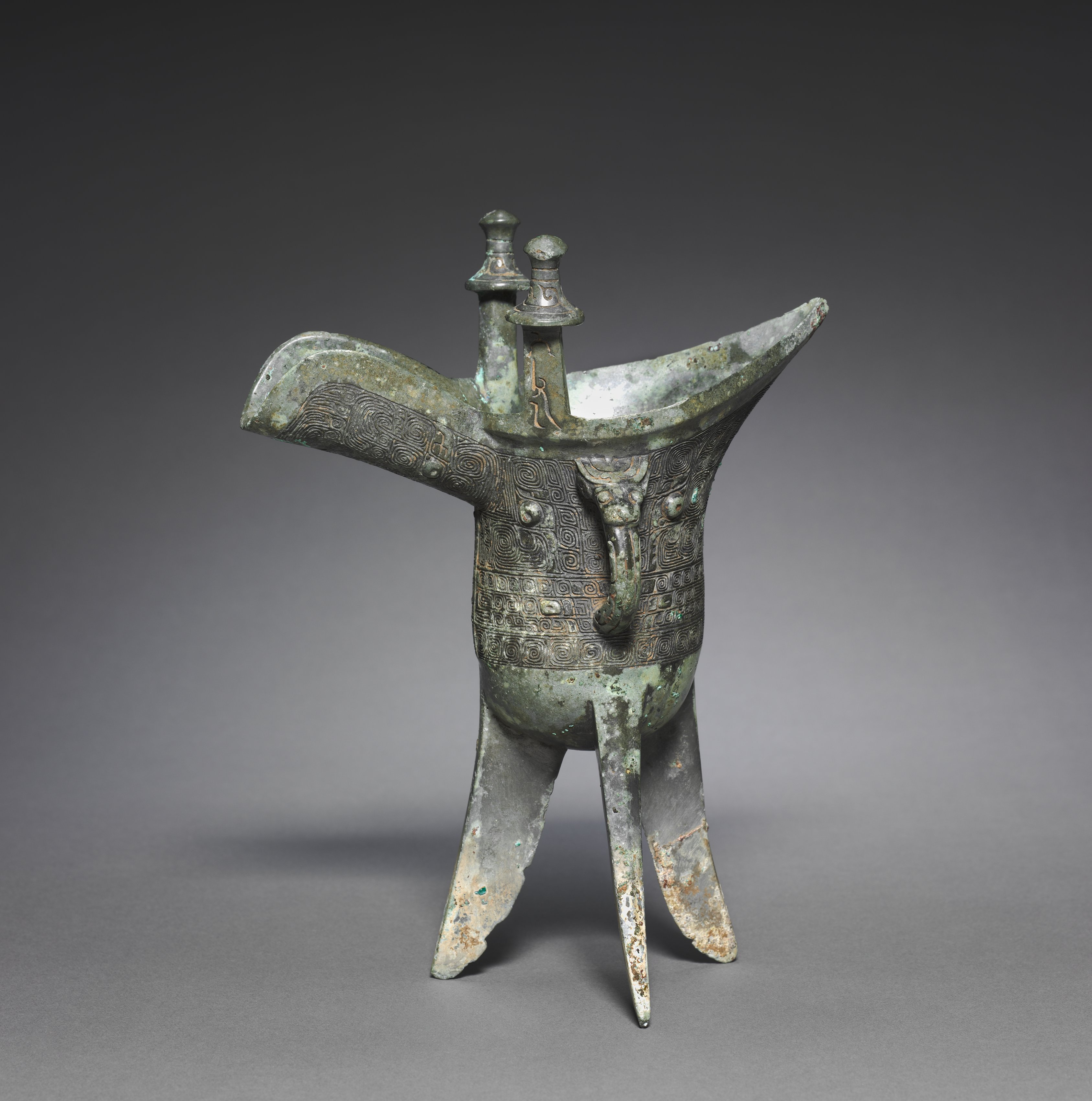Jue (vessel) on:
[Wikipedia]
[Google]
[Amazon]
 A ''jue'' () is a type of ancient Chinese vessel used to serve warm wine during
A ''jue'' () is a type of ancient Chinese vessel used to serve warm wine during
 A ''jue'' () is a type of ancient Chinese vessel used to serve warm wine during
A ''jue'' () is a type of ancient Chinese vessel used to serve warm wine during ancestor-worship
The veneration of the dead, including one's ancestors, is based on love and respect for the deceased. In some cultures, it is related to beliefs that the dead have a continued existence, and may possess the ability to influence the fortune of t ...
ceremonies. It takes the form of an ovoid body supported by three splayed triangular legs, with a long curved spout (''liu'' 流) on one side and a counterbalancing flange (''wei'' 尾) on the other. Many examples have one or two loop handles (''pan'' 鋬) on the side and two column-shaped protuberances (''zhu'' 柱) on the top of the vessel, which were probably used to enable the vessel to be lifted using leather straps. They are often ornately decorated with ''taotie
The ''Taotie'' () is an ancient Chinese mythological creature that was commonly emblazoned on bronze and other artifacts during the 1st millennium BC. ''Taotie'' are one of the " four evil creatures of the world". In Chinese classical texts such a ...
'' decorations representing mythical beasts. They are in effect a small Chinese equivalent of the ewer
In American English, a pitcher is a container with a spout used for storing and pouring liquids. In English-speaking countries outside North America, a jug is any container with a handle and a mouth and spout for liquid – American "pitchers" wi ...
. The name ''jue'' is not original, but derives from the ''Shuowen Jiezi
''Shuowen Jiezi'' () is an ancient Chinese dictionary from the Han dynasty. Although not the first comprehensive Chinese character dictionary (the ''Erya'' predates it), it was the first to analyze the structure of the characters and to give t ...
'', a dictionary of the 2nd century AD.
The vessel originated in Neolithic times as a pottery ware associated with the Longshan culture
The Longshan (or Lung-shan) culture, also sometimes referred to as the Black Pottery Culture, was a late Neolithic culture in the middle and lower Yellow River valley areas of northern China from about 3000 to 1900 BC. The first archaeological fi ...
, between about 2500-2000 BC. During the Shang and Zhou dynasties of Bronze Age China
The Bronze Age is a historic period, lasting approximately from 3300 BC to 1200 BC, characterized by the use of bronze, the presence of writing in some areas, and other early features of urban civilization. The Bronze Age is the second prin ...
, it became one of a number of designs of Chinese ritual bronze
Sets and individual examples of ritual bronzes survive from when they were made mainly during the Chinese Bronze Age. Ritual bronzes create quite an impression both due to their sophistication of design and manufacturing process, but also bec ...
s. Pottery and lead copies continued to be made and used as grave goods
Grave goods, in archaeology and anthropology, are the items buried along with the body.
They are usually personal possessions, supplies to smooth the deceased's journey into the afterlife or offerings to the gods. Grave goods may be classed as a ...
or spirit utensils (''mingqi''). Most ''jue'' (like other Chinese bronzes) were created by casting molten metal in pottery moulds, but one ''jue'' appears to have been made using the much earlier method of hammering sheet metal that might have been introduced from western Asia, where bronze metallurgy is believed to have been developed 2,000 years before it appeared in China.
''Jue'' were the commonest type of vessel found in the tombs of elites during the Shang dynasty. Their ritual use is indicated by oracle bone
Oracle bones () are pieces of ox scapula and turtle plastron, which were used for pyromancy – a form of divination – in ancient China, mainly during the late Shang dynasty. '' Scapulimancy'' is the correct term if ox scapulae were used for ...
inscriptions that suggest that they were used to heat and pour wine during oracular ceremonies in which the owner's ancestors and the Supreme Deity (''Shangdi
Shangdi (), also written simply, "Emperor" (), is the Chinese term for "Supreme Deity" or "Highest Deity" in the theology of the classical texts, especially deriving from Shang theology and finding an equivalent in the later '' Tian'' ("Heave ...
'' 上帝) were invoked. They were also used in temple ceremonies to mark particular festivals. Traces of soot have been found on the legs and bottoms of a few''jue'', indicating that some of them were placed directly into fires to heat their contents. However, this appears in only about 5% of the ''jue'' excavated in archeological sites, so should be viewed as an exception rather than a rule.
According to the later Zhou-era '' Book of Etiquette and Ceremonial'', it was used in formal settings with a prescribed set of ritual actions. After being lifted from its bamboo hamper, it was to be rinsed, lifted with one hand, emptied, set down and put back in its hamper. The drinker would praise the wine while the host would decline to do so, out of modesty. Similar rituals were conducted with the ''zhi'' (卮/巵/梔), another type of wine vessel. Analogous ceremonies are described in the ''Book of Rites
The ''Book of Rites'', also known as the ''Liji'', is a collection of texts describing the social forms, administration, and ceremonial rites of the Zhou dynasty as they were understood in the Warring States and the early Han periods. The ''Book ...
'', another Zhou text.
References
{{DEFAULTSORT:Jue (Vessel) Chinese bronzeware Drinkware